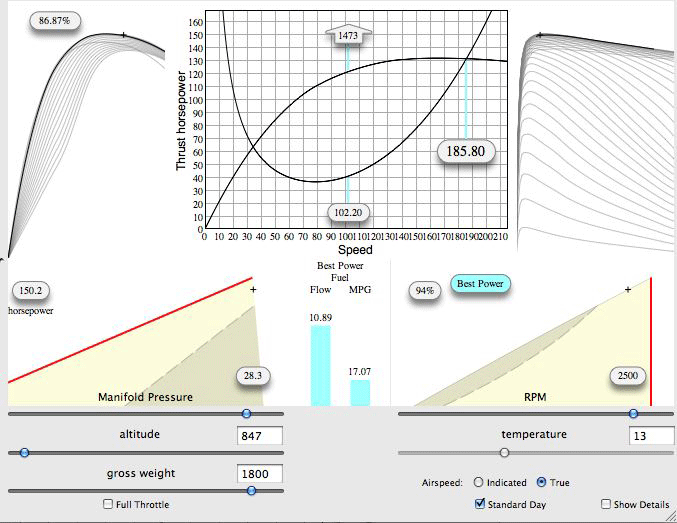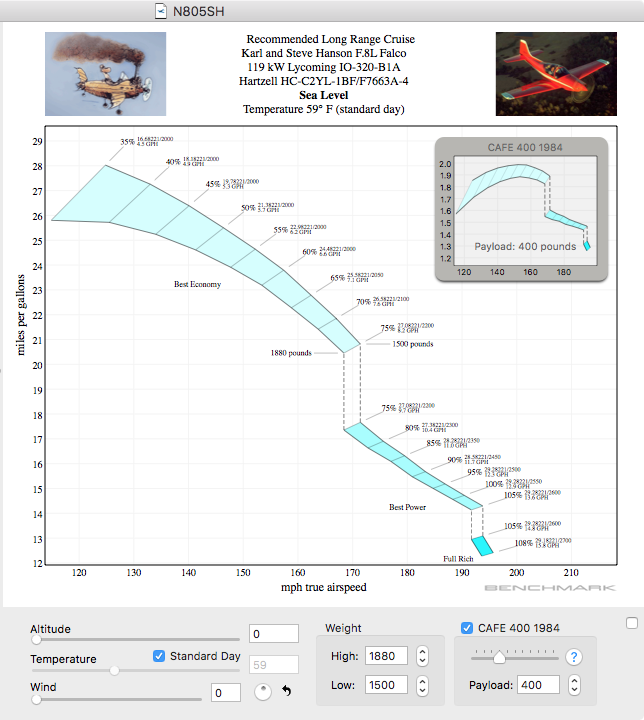Av Engineer? Have Macintosh? Prepare to go straight to heaven.
![]()
Av Engineer? Have Macintosh? Prepare to go straight to heaven. |
|
Benchmark brings the power of a Boeing batallion by Ron Wiener
For airplane engineers to derive specific performance graphs on a new airplane can be a task that consumes months of painstaking measurement and calculation. Now, thanks to Alfred P. Scott, president of the Sequoia Aircraft Corporation, a software tool has been devised that will make any aerodynamics engineer believe he has died and gone to heaven. Six years in the making, Sequoia's "Benchmark" program brings you the power of a small battalion of Boeing engineers and literally turns a once onerous task into a fun exercise. Benchmark is getting good report cards from a number of demanding customers. According to Scott, the CAFE Foundation, in conjunction with the EAA, is setting up a flight-testing center at Santa Rose, California to do definitive performance testing of homebuilt aircraft—all centered around the Benchmark software as the analysis tool. A vendor of high-fidelity flight simulators has also reported that Benchmark is being used to obtain the performance particulars of various aircraft in order to more rapidly create custom, aircraft-specific, software modules. Indeed, there are numerous applications for this powerful little package, even for the private-plane owner who just wants to get the specifics (as opposed to factory specs) on the performance of his individual aircraft. For the aircraft designer or manufacturer, it's simply a slice... Scott, who authored the program himself, admits right up front in the documentation that Benchmark is still undergoing major construction. But don't let this startling admission detract from Benchmark's already vast capabilities and pioneering talents. As it stands, the program can be used to generate the analysis and performance graphs for almost an entire flight manual for any given aircraft. Aircraft manufacturers spend upwards of $25,000 in engineering expenses coming up with the same data that you can now generate with Benchmark in a matter of hours. Using this program you can determine such nice-to-know figures such as the optimum power settings for fuel efficiency, or speed, at any altitude and temperature, given your aircraft, engine and propeller characteristics. If all this sounds complicated, it is — sort of. The program's documentation includes a 100-page reference manual complete with a tutorial on how to conduct the flight tests. Nevertheless, it takes some engineering or technical background to handle (and appreciate) the sophistication of this program. The user interface has been given last attention in an effort to get the important parts of this program completed, so non-engineers may find this aspect of Benchmark a little frustrating (whereas engineers are more used to working with software before the front-end has been prettied up.) Having said that, no special piloting skills are required in order to conduct the flight tests, nor is any specific engineering or physics knowledge required to accomplish the, analysis tasks. |

Benchmark borrows the basic performance data from the engine manufacturer's sea-level performance chart and utilizes "curve-fitting" techniques to calculate the engine's performance at any pressure altitude, temperature, manifold pressure or rpm. Engine-power calculations are built in and the program also displays brake mean effective pressure, as well as fuel flow and specific fuel consumption. Instrument and pitot-static errors are handled by fitting curves to calibration data of indicated vs. actual, thus providing for great accuracy in the final results. The key flight test is the "drag polar flight test," in which you fly the airplane at various power settings in order to supply Benchmark with the raw information it needs to compute two essential values: Cdo and Oswald E (if you wish to use Benchmark as a design tool, you can simply enter the variables.) Once these values are obtained, you can "fly" the airplane at any altitude, temperature, power setting or weight using Benchmark's airplane speed calculator. |

This calculator plots the curves for power required and power available on the screen, and displays the fuel flow, miles per gallon and best rate of climb for each calculation. It becomes easy, in a sense, to pop a different propeller or engine on your airplane and see what the resulting performance might be like. Additional calculation functions of the program include "Atmospherics," for computing the normally-used pressure, temperature and density ratios for air, and calculating the true airspeed of an aircraft based on these ratios — plus other trivial information such as temperature correction for adiabatic compression, the dynamic pressure Q and the Mach number of the aircraft. (Got that, now?)
|
|
|